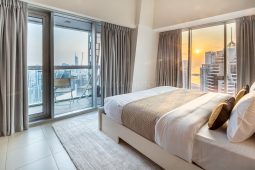PR for Interior Designers in 2026
What Every Interior Designer Should Know about PR
Let’s talk about the elephant in your beautifully designed room: PR is a pain in the ass.
The design world has never been noisier. Between viral TikTok “cores” (Coastal Grandmother, Mob Wife, Cherry Mocha—take your pick) and every influencer suddenly “reimagining” minimalism, it’s harder than ever to stand out. But here’s the good news: editors are always on the hunt for something fresh, and that could totally be you.
My company does PR for interior designers, which means I spend my days building relationships with editors who have the power to feature my clients’ work in magazines that people flip through while…wait, are people still flipping through magazines? Turns out, YES, although much has moved to digital.
Here’s the juicy part: That could totally be YOU giving expert quotes and having your work featured.
I’ve been helping designers earn meaningful press for almost two decades. And I’ve noticed something: trying to DIY your own PR while running a design business is like trying to paint a ceiling while also making soufflé. Something’s gonna collapse.
And pitching yourself? Awkward City, population: You. Trust me, I GET IT. I pitch clients all day long, but when it comes to my own PR, I’d rather clean grout with a toothbrush. Even though this is literally my job, my own PR gets pushed so far down my to-do list it’s hanging out with “learn Spanish” and “start meditating.”
So if you’re not doing it either, I’m not judging. We’re in this procrastination boat together, floating on a sea of “I’ll get to it tomorrow.”
But whether you’re PR-curious or PR-serious, these tips are non-negotiable for getting your gorgeous work the attention it deserves. (And I cannot stress #3 more unless I used ALL CAPS and hired a skywriter.)
7 PR Tips Every Interior Designer Should Follow
(Unless You Enjoy Being Design’s Best-Kept Secret)
1. HAVE A POINT OF VIEW
“I can design in any style!” might seem client-friendly, but it’s the equivalent of bringing lukewarm soup to a potluck. Nobody remembers lukewarm soup.
Many designers are terrified of putting themselves in a box. But here’s the truth from a marketing persepctive: if you want to stand out, you need to stand FOR something.
That means being okay saying “no” to projects that don’t align with your vision. Scary? Absolutely. When I first started saying no to clients who weren’t a fit, my bank account panicked. But once I got clear on who my dream clients were, those “no’s” made room for better “yeses.”
My client Lisa went from $850K to $2.25M in a year by tightening her positioning and learning that “no” is a complete sentence. That kind of clarity makes for great storytelling—something editors and podcast hosts love. Think about what lessons you’ve learned that might inspire others in your field.
2. PHOTOS ARE THE HOLY GRAIL
No photos = no press. End of story.
You need professional photography even if you’re not chasing press yet. Your website is your biggest marketing tool, and iPhone photos with uneven lighting won’t do your work justice.
Here’s the shift we’re seeing: editors want lived-in, layered spaces—rooms that feel like someone just set down their coffee, not like a decorator vanished five minutes ago. That’s where an interior stylist comes in. Styling for camera is different than styling for life. Think of it like makeup: one is for everyday, the other is for HD close-ups.
Another rookie mistake? Not having enough photos to tell a full story. Aim for 25–30 diverse shots per project, more for larger homes. And before you shoot, negotiate usage rights with your photographer. You don’t want to find out later that your favorite magazine can’t run your images without an extra $2K licensing fee.
If you need more help with understanding what editor want, I break down what editors are looking for in this quick video.
3. EDUCATE YOURSELF
If you’re pitching a layered English Countryside project to Dwell, you might as well be pitching snow cones in Antarctica.
You’ll get press when you understand which outlets actually feature your kind of work. That means—you guessed it—reading them. Make it part of your job. Grab a coffee, flip through the latest issues, and pay attention to what they’re publishing. If you haven’t read Domino in a while, you might be surprised by what kind of home tours they’re publishing lately!
When designers come to me for help, my first question is, “What’s your dream publication for this project?” While it’s my job to guide you, it’s always a good sign when you’ve done your homework. It shows you’re serious about strategy, not just hoping for a lucky break.
4. SOCIAL MEDIA IS IMPORTANT
Instagram may not be what it was five years ago, but it’s still the design world’s most visible stage. It’s where editors, stylists, and potential clients discover new talent.
Think of it as your digital portfolio—curated, intentional, and consistent. Some designers who are great at this: @sarahshermansamuel, @coreydamenjenkins, @amberinteriors, and @emilyhenderson. They use it not just to share projects but to communicate a clear aesthetic and point of view.
You don’t need to post every day, but what you do share should feel elevated, on-brand, and unmistakably you.
5. INVEST IN VISUAL BRANDING
Your website and social media are the first things editors see when I pitch you—and they absolutely influence whether we get a yes.
If your site feels outdated or your logo looks like it was designed during the Pinterest chevron era, it’s time for a refresh. You’re in the business of aesthetics; your brand presentation should reflect that.
A strong digital presence isn’t just about looking good—it builds trust and makes my job (and yours) exponentially easier.
6. THINK BEYOND THE PROJECT
Design publications are as interested in the story as they are in the space. Who lives there? What’s the emotional hook?
If your project happens to involve a recognizable client or a homeowner with an interesting platform, even better. (People are endlessly curious about how others live—especially public figures.)
That said, don’t force it. If you’re newer, focus on telling your own story: your process, your growth, your creative philosophy. Every designer has something compelling; it just takes a bit of digging to find the narrative thread.
7. INVEST IN AN INTERIOR DESIGN PUBLICIST
Even the most established designers struggle to find the time to pitch, follow up, and build media relationships. That’s where a good publicist comes in.
Your job is to design beautiful spaces; ours is to make sure the right people see them. Whether that’s through ongoing representation, a one-time project placement, or a membership like our Library Card program, having PR support can open doors that cold pitching simply won’t.
The post PR for Interior Designers in 2026 appeared first on The Sought After.





